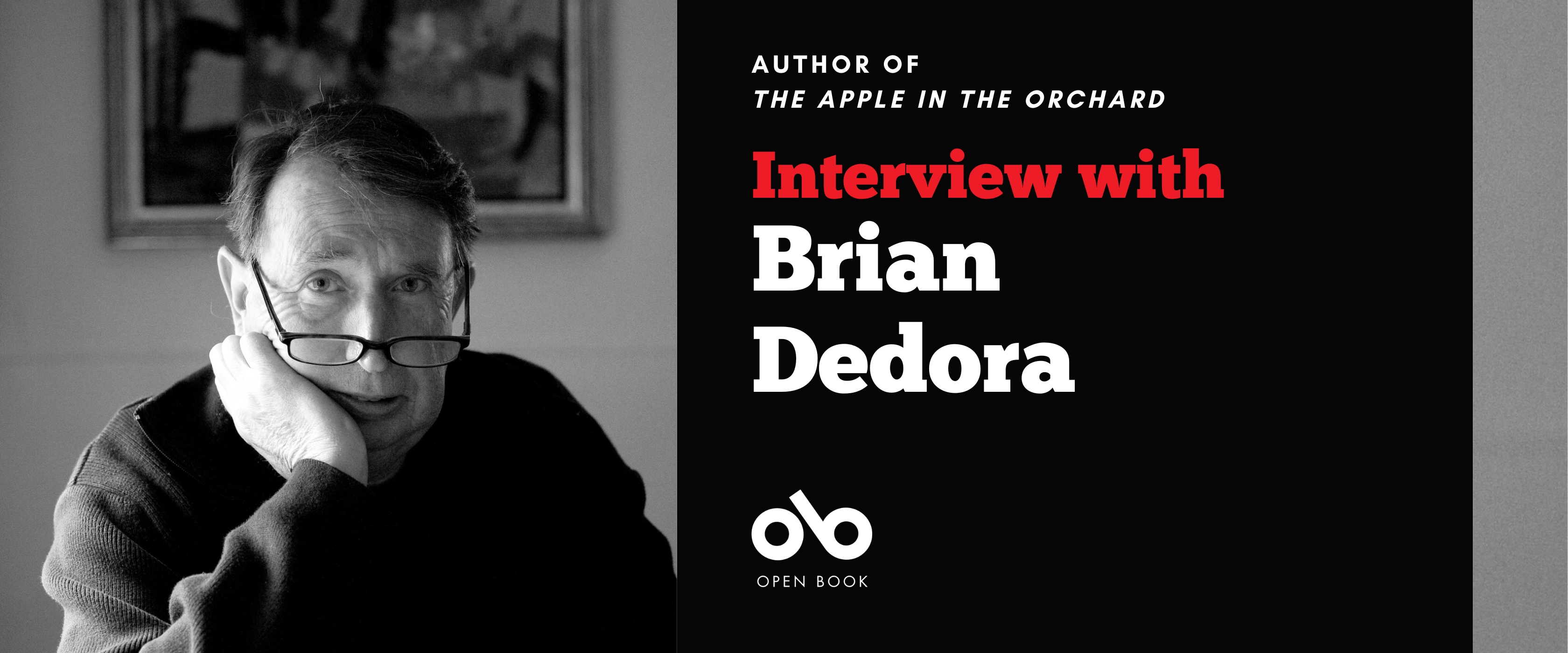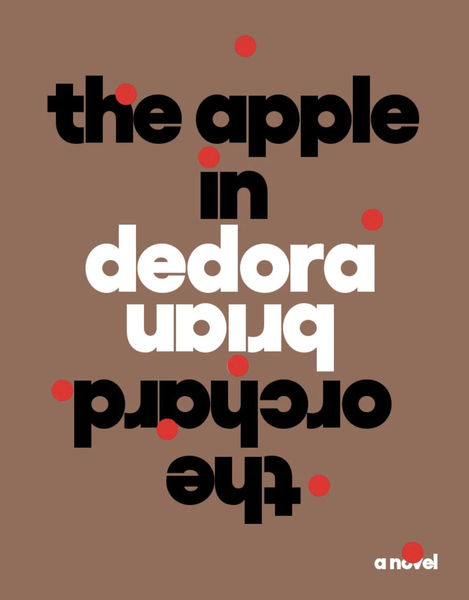Brian Dedora Navigates the Truths and Half-Truths of a Traveller in The Apple in the Orchard
The wanderings of a lone traveller through the wilderness, rural and urban, can be harrowing and fraught. But what if the most dangerous journey that traveller must take is a journey into memory?
Experimental literature veteran Brian Dedora delves into the past in his third novel, The Apple in the Orchand (Guernica Editions), framing the story around a reveller in an upscale Toronto restaurant who appears on a winter's night and begins to weave his tales. His truths and half-truths spill out in layers, just as the novel itself takes shape in prose fragments and narrative threads that come in and out of focus.
It's a complex, fluid work that explores myths of the North, the traps of city streets, class and familial tensions, sexuality, and the tragic story of an unnamed Her that haunts this lone traveller. Dedora weaves this all together expertly into a portrait of one man and his memories of a life lived.
The author is here today to tell our readers more about this fascinating novel, as part of our Long Story novelist interview series.
Open Book:
Do you remember how you first started this novel or the very first bit of writing you did for it? This also incorporates question number, 10: Did you include an epigraph in your book? If so, how did you choose it and how does it relate to the narrative?
Brian Dedora:
This readable experimental novel came about in bits and pieces later revised into vignettes. The epigraph that begins the book was written with no further movement to something larger until I realized, as I had set the novel in a fashionable Toronto restaurant called La Bastingo, that the wine bottle description led into the entire setting of the book...but that took a while.
The start of the book was in no sense a beginning because its foundation was in several notebooks with a paragraph here, a couple over there that had at first no intention of coalescing to what a reader will now read. I don’t want you to think this is some hocus pocus performance, but I just kept jotting things down as they occurred to me until they built up to a realization that all this seemingly disparate writing was one thing. The light bulb moment came while I was in Spain (I could see Canada from a distance)where I got into a mode or bubble wherein the many Canadian tropes this book pokes at became clear and I was writing almost possessed as I let the voice that speaks this book have free reign... it was exhilarating but also exhausting as ideas came pouring out and I wanted to follow them, get them down...oddly there was a kind of Irish voice in me that’s not apparent in the novel but a voice I listened to.
It is this energy that required the incomplete sentences and galloping triple descriptors I use throughout the novel as they have the quickness of thought and not the “subject object verb plod” that is necessary for explanation as the book contains the same register as the quick and urgent writing that was flowing that I didn’t want to stop. All those disparate pieces are represented by vignettes whose conglomeration form the book.
OB:
How did you choose the setting of your novel? What connection, if any, did you have to the setting when you began writing?
Your CanLit News
Subscribe to Open Book’s newsletter to get local book events, literary content, writing tips, and more in your inbox
BD:
The use of the restaurant where the un-named narrator attends was a place quite famous in 1980s Toronto and a restaurant I also dined at, so this wee bit of autobiography became the setting as it was not only familiar but the perfect place for a lone diner to begin the most dangerous of things: He begins, aided by some “light gold champagne” a journey into memory, where, for me, the fun began because memory can go anywhere. And that anywhere is Canada’s north, the secret places where youth begin to explore sexuality, and the story found in the accidental discovery of a notebook and a photograph. The presence of photographs was a breakthrough moment in the writing where the un-named “Her” is brought to life through the capture of text-photos dispersed as leading discoveries throughout the novel.
OB:
Did the ending of your novel change at all through your drafts? If so, how?
BD:
The ending of the novel was another burst or realization of where all that disparate coming together was leading to and where it led was a tragedy that was underlying the narrator’s meandering sojourn until it no longer meandered but hit face first such that it ends the evening in the restaurant. It is in the ending that the entire thrust of the novel is set, such that the begging of forgiveness gives way to questions of who is this narrator, a narcissist or one of the wounded?
This ending was not present when I first began the writing. So, to answer the question did the ending change through the various drafts, yes, because it crept up to me and almost caught me,
writing-wise, off guard. It was one of a series of light bulb moments that propelled the novel in ways that were not laid out. In all my writing I have never set out at A to end at Z because it’s all free flow until it’s not and that is the joy of my writing and what I learned from the APPLE was to trust the process yet again, just follow because you own content and its form will be found through, in my case, the coalescent vignettes and the marvel of revision where I could tie the parts together or simply lay them side by side, a process enjoyable, exhaustive, and hilarious.
OB:
Did you find yourself having a “favourite” amongst your characters? If so, who was it and why?
BD:
The characters one meets in the book come and go as quick as memory and thought, but there is one that receives an entire vignette, and he is GREY OWL. Archie Belaney, an Englishman,
manufactured an Indigenous identity while abandoning wife and children to become a poster boy furthering the image of Canada and the True North. He was a feature in National Film Board productions, he was photographed by the most famous portrait photographer in Canada, Josef Karsh, and was a Canadian representative visiting the King and Queen. What fascinates me is the fact no vetting was done before he became the adulated, Grey Owl. Vetting has become a present Canadian problem where our governments have embarrassed the entire country with their naivety and seeming inability to find out who is it that becomes the recipient of various governmental honours, positions, ministers waving white gloves from the backseats of limos.
What is worse is the deception I wrote about is not just Grey Owl’s but our entire herd that would for some momentary dazzle forget we are the terror of the wolves.
OB:
If you had to describe your book in one sentence, what would you say?
BD:
A reveller on a Toronto winter’s night begins the most dangerous of things, he begins to remember.
OB:
What was the strangest or most memorable moment or experience during the writing process for you?
BD:
After I had laid out all those disparate pieces and was finding some degree of order I spoke with my friend and previous editor of my books about what I was doing, Bev Daurio asked if she could read the manuscript and I said yes. Her reading engendered an eight month back and forth between us that questioned the relevancy of certain vignettes with observations about the integration of various passages and subtle prods concerning the un-named HER and how a reader could get a further sense of HER. I was thrown into a fright as I worried about finding that voice and what I could say. A day or so later with a bulb flash I knew in an instant that I would write a series of “text-photos” complete with old tyme photo corners to capture a growing understanding of who HER is which can then be interspersed throughout the book like a family photo album. The other memorable moment came when Stuart Ross approached me about this manuscript to ask if I still had it, yes. Later, at a small press fair, Stuart told me I would be the first writer published by 1366Books, through Guernica Editions, being an imprint dedicated solely to experimental prose... I gave him a bear hug...twice!
OB:
Did you celebrate finishing your final draft or any other milestones during the writing process? If so, how?
BD:
After a light edit by Stuart Ross and some back and forth between us plus a suggestion to write three more small vignettes titled the Beloved buyer wherein, we discover a bit more about the un-named narrator (twelve to fifteen edits before I was happy with them) plus layout and typesetting decisions with Stuart, I was able to send the “new” manuscript in. My partner, throughout this month and a half long process kept asking, “Earth to Brian...?” where I was thinking of verbs, photo captures, paragraph placements etc. and was in some edit world where I needed to come down which happened after I clicked “send” and then slept for two days.
It was done!!
___________________________________________________
Brian Dedora is a master gilder, artist, photographer, and writer. He has been writing since 1977 and has published extensively. Dedora’s book A Slice of Voice at the Edge of Hearing (2008) was a finalist for the Relit Award and the George Ryga Prize. His titles A Few Sharp Sticks (2011); Lot 351 (2013); and Eye Where (2014), a book of his visual work from the 70s and 80s, followed, each published by Mercury Press & Teksteditions in Toronto. Dedora’s titles have been published around the world including Lorcation (2015, Editorial Visor, Madrid/BookThug, Toronto); Paper Poems (2021, RedFox Press, Ireland); and Polaroid Poems (2022, Paper View Press, Portugal).
Originally from Vernon, B.C., Dedora is currently based in Toronto where he continues to write and hone his skills in film photography with his vintage cameras: Rolleiflex, Hasselblad, and Leica.






